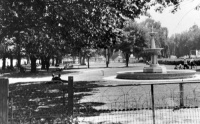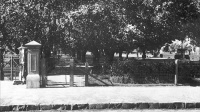Robertson Park
From The Orange Wiki
When Orange was laid out in 1846 more than 14% of the ‘square mile’ was devoted to parks and public open space but 30 years passed before Council had the funds to do anything with them. Robertson Park, named after the Premier Sir James Robertson, was dedicated in 1887 and planted with shady trees. Concreting of the Blackman’s Swamp Creek bed which crosses the area diagonally began in the same year. The creek which overflowed periodically, causing much damage to properties near Lords Place was of great concern to Council. The channel was completed in 1893 and roofed over in 1937. The Park was so vital to the City’s central business district the Council made a serious effort to reclaim it in 1892 by creating walks and providing seating.
The marble fountain on the Summer Street frontage was the gift of Cobb and Co in 1896, in honour of William Franklin Whitney, one of the partners in the firm. It is said to have been paid for by docking the wages of the employees.
The first bowling club in Orange was established in Robertson Park in 1900 with the existing CWA Hall operating as the club pavilion. In 1913 club members were described as enthusiastic and skilled players ‘and it would be a poor heart which could not find rest and enjoyment in watching the competing games’.
In 1927 the ornate entrance gates at Robertson Park were moved to Cook Park and installed at the corner of Summer Street and Sampson Street.
Gradually the park has become an important place for war memorials and remembrance services. The Cenotaph was built in 1952 and since then it has been the focus for Anzac Day ceremonies in Orange.
Over the past 50 years, the park has become a civic space and most recently a focal point for Slow Summer and Christmas celebrations.
- Miller, J., Holmes, D., and Honey, A. 2001, Orange a vision splendid, Orange City Council, Orange NSW.
- Orange and District Illustrated 1989, Orange City Council, Orange NSW.
- Robertson Park takes on centre stage an exhibition curated by the Orange and District Historical Society (2009)


